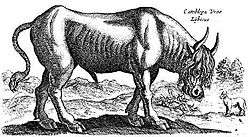Catoblepas

The catoblepas (pl. catoblepones; from the Greek καταβλέπω, (katablépō) "to look downwards") is a legendary creature from Ethiopia, first described by Pliny the Elder and later by Claudius Aelianus.
Description
It is said to have the body of a cape buffalo. Its head is always pointing downwards due to its head being heavy. Its stare or breath could either turn people into stone, or kill them. The catoblepas is often thought to be based on real-life encounters with wildebeest, such that some dictionaries say that the word is synonymous with "gnu". Also known as an African version of a Gorgon.[1]
Ancient and medieval descriptions
Pliny the Elder (Natural History, 8.77) described the catoblepas as a mid-sized creature, sluggish, with a heavy head and a face always turned to the ground. He thought its gaze, like that of the basilisk, was lethal, making the heaviness of its head quite fortunate.
Claudius Aelianus (On the Nature of Animals, 7.6) provided a fuller description: the creature was a mid-sized herbivore, about the size of a domestic bull, with a heavy mane, narrow, bloodshot eyes, a scaly back and shaggy eyebrows. The head was so heavy that the beast could only look down. In his description, the animal's gaze was not lethal, but its breath was poison, since it ate only poisonous vegetation.
In literature
The catoblepas is described in The Notebooks of Leonardo da Vinci:
It is found in Ethiopia near to the source Nigricapo. It is not a very large animal, is sluggish in all its parts, and its head is so large that it carries it with difficulty, in such wise that it always droops towards the ground; otherwise it would be a great pest to man, for any one on whom it fixes its eyes dies immediately.
In The Temptation of Saint Anthony (1874), Gustave Flaubert describes it as:
...a black buffalo with the head of a hog, hanging close to the ground, joined to its body by a thin neck, long and loose as an emptied intestine. It wallows flat upon the ground, and its legs are smothered under the huge mane of stiff bristles that hide its face.
In The Countess of Pembroke's Arcadia (The New Arcadia) (c. 1670–86), by Sir Philip Sidney, the "forsaken knight" that Amphilalus fights has a Catoblepas upon his crest:
So passed he over into the island, taking with him the two brothers of Anaxius; where he found the forsaken knight attired in his own livery, as black as sorrow itself could see itself in the blackest glass: his ornaments of the same hue, but formd into the figures of ravens which seemed to gape for carrion: only his reins were snakes, which finely wrapping themselves one within the other, their heads came together to the cheeks and bosses of the bit, where they might seem to bite at the horse, and the horse, as he champed the bit, to bite at them, and that the white foam was engendered by the poisonous fury of the combat. His impresa was a Catoblepta, which so long lies dead as the moon (whereto it hath so natural a sympathy) wants her light. The word signified, that the moon wanted not the light, but the poor beast wanted the moon's light.
The Catoblepas was listed in the Book of Imaginary Beings (1957) by Jorge Luis Borges. It is described as a black buffalo with a hog's head that is always looking down.